Starting and Exiting Desktop Editor
This section describes the procedure for starting Desktop Editor to open documents and exiting Desktop Editor.
|
NOTE
|
|
For more information on the functions of Desktop Editor, see the following.
|
Starting Desktop Editor
This section describes how to start Desktop Editor to open documents.
|
IMPORTANT
|
|
When Desktop is started by selecting [Run as administrator] in Windows, the Desktop operations are not guaranteed.
PDF documents with Reader Extensions are converted to IWB documents with the Reader Extensions function deleted.
If the Reader Extensions function is added to an IWB document created with an older version of Desktop, the Reader Extensions function is deleted when the IWB document is opened. However, the Reader Extensions function is not deleted from the original document.
If you edit or save a PDF document in the PDF/A format with Desktop Editor, the document will no longer conform to the PDF/A format.
|
|
NOTE
|
|
You can start more than one instance of Desktop Editor.
A single Desktop Editor screen enables you to edit only a single document.
The Desktop Editor screen is started and displayed in the same position, size, and screen structure as when it was last terminated.
If you switch the user of the computer to return to the user that started Desktop Editor, a message indicating the printer configuration information is displayed.
For information on how to open a document by starting Desktop Editor from Therefore, see the following.
Opening Documents Saved in Therefore with Desktop Editor (Administrator Guide)
|
Starting Desktop Editor from the Start Menu to Open Documents
This section describes how to start Desktop Editor from the Start menu to open documents.
The types of documents that can be opened by starting Desktop Editor from the Start menu are indicated below.
IWB documents (*.iwb)
PDF documents (*.pdf)
iW documents (*.iwd)
1.
Select the [Start] menu > [All Programs] > [Canon iW Desktop] > [iW Desktop Editor].
Or, follow one of the steps described below.
Right-click on the shortcut icon for [iW Desktop Editor] created on the desktop and select [Open].
Double-click on the shortcut icon for [iW Desktop Editor] created on the desktop.
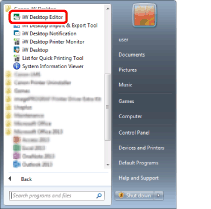
Desktop Editor is started.
|
NOTE
|
|
For Windows 8.1, click
For Windows 10, select the [Start] menu > [Canon iW Desktop] > [iW Desktop Editor]. Desktop Editor starts.
The shortcut for [iW Desktop Editor] is automatically created during the installation of Desktop.
|
2.
Click [Open from Library] or [Open from Windows Folders] on the ribbon.
Or, select the [File] menu > [Open] > [Open Library Document] or [Open Windows Folder Document].
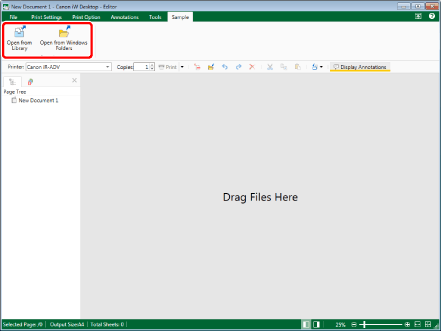
[Open] is displayed.
To open a document in a library other than a Therefore Library or a document in a Windows Folder, proceed to step 3.
To search for documents in [New Search] in a Therefore Library, proceed to step 4.
To open a document in a Therefore Library search condition, proceed to step 6.
|
NOTE
|
|
If commands are not displayed on the ribbon of Desktop Editor, see the following to display them.
The same operation can also be performed with the tool buttons. If tool buttons are not displayed on the toolbar of Desktop Editor, see the following to display them.
If [Connect to Library] or the dialog box for authentication is displayed, enter the user name in [User Name] and password in [Password] and then click [OK].
|
3.
In [Document Type], select the type of document to open.
Documents of the selected type are displayed. Proceed to step 7.
4.
Double-click [New Search].
[New Search] is displayed.
5.
Configure the search condition, and click [Search].
Documents corresponding to the configured search condition are displayed. Proceed to step 7.
|
NOTE
|
|
For details on [New Search], see the following.
|
6.
Select the search condition.
The documents are displayed.
7.
Select the document, and click [Open].
Desktop Editor is started in another screen, and the selected document is displayed.
|
NOTE
|
|
When you select a PDF document with a password set and click [Open], [Enter Password] is displayed.
When you select a PDF document that has both a password to open the document and a permissions password set, or a PDF document with only a password to open the document set, enter the password and click [OK].
When you select a PDF document that has only a permissions password set, select [Enter password and open], enter the password, and click [OK]. If you select [Display only], you cannot edit, copy, save, or print the document in Desktop Editor.
In both of the above cases, an error message is displayed if you fail to enter the correct password three times.
When you select a PDF document with the Reader Extensions function and click [Open], a confirmation message is displayed.
Click [Open] if it is OK to delete the Reader Extensions function.
To retain the Reader Extensions function, click [Open Read Mode]. In this case, you cannot edit or save the document in Desktop Editor.
When you select a PDF document in the PDF/A format and click [Open], a confirmation message is displayed.
To edit a document, click [Open]. If you edit or save a document with Desktop Editor, the document will no longer conform to the PDF/A format.
To keep the document in the PDF/A format, click [Open Read Mode]. In this case, you cannot edit or save the document in Desktop Editor.
If a message is displayed to confirm whether or not to check it out, click [Yes]. The message displayed when checking out can also be hidden. For more information, see the following.
|
Starting Desktop Editor from Desktop Browser to Open Documents
This section describes how to start Desktop Editor from Desktop Browser to open documents.
|
NOTE
|
|
If you select the [Save the original document in Canon Desktop Document] check box in [System Settings], the original document is stored in the IWB document.
[File] menu > [Option] > [System Settings] > [Editor] > [Options] > [Save the original document in Canon Desktop Document]
|
1.
Select the document to open with Desktop Editor on the Desktop Browser screen.
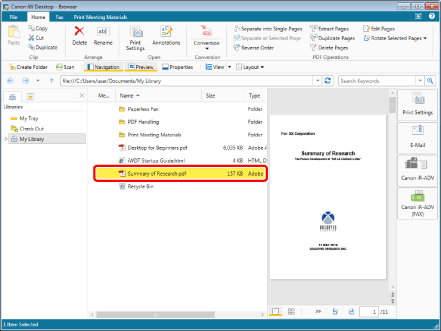
2.
Click the [Print Settings] output button.
Or, follow one of the steps described below.
All types of documents that can be operated with Desktop Editor:
Click [Print Settings] on the ribbon
Drag and drop the selected document to the [Print Settings] output button
Right-click and select [Edit and Print Settings with Editor]
IWB documents/PDF documents:
Click [Annotations] on the ribbon.
Select [Open] on the ribbon > [Open].
Click the icon for the ribbon command.
Click [Open] on the ribbon.
Right-click and select [Open] or [Insert Annotations].
Double-click the IWB document (*.iwb) or PDF document (*.pdf).
Press the [Enter] key on the keyboard.
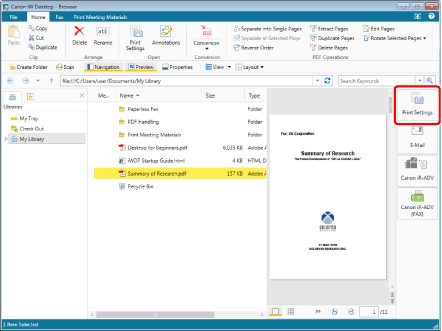
Desktop Editor is started, and the selected document is displayed.
|
NOTE
|
|
For information on the types of documents that can be operated using Desktop Editor, see the following.
When you open a document other than an IWB document with Desktop Editor, the document is converted to an IWB document, except when opening a PDF document by clicking [Annotations]/[Open] on the ribbon, by selecting [Open]/[Insert Annotations] in the right-click menu, by double-clicking it, or pressing the [Enter] key.
If commands are not displayed on the ribbon of Desktop Browser, see the following to display them.
The same operation can also be performed with the tool buttons. If tool buttons are not displayed on the toolbar of Desktop Browser, see the following to display them.
When you open a PDF document with a password set, [Enter Password] is displayed.
When you open a PDF document with the [Print Settings] output button, [Print Settings] on the ribbon, or by selecting [Edit and Print Settings with Editor] in the right-click menu, enter the password and click [OK].
When you open a PDF document by clicking [Annotations]/[Open] on the ribbon, by selecting [Open]/[Insert Annotations] in the right-click menu, by double-clicking it, or by pressing the [Enter] key, perform the following operation.
When you select a PDF document that has both a password to open the document and a permissions password set, or a PDF document with only a password to open the document set, enter the password and click [OK].
When you select a PDF document that has only a permissions password set, select [Enter password and open], enter the password, and click [OK]. If you select [Display only], you cannot edit, copy, save, or print the document in Desktop Editor.
In both of the above cases, an error message is displayed and then a blank Desktop Editor screen is displayed if you fail to enter the correct password three times.
When you open a PDF document with the Reader Extensions function by clicking [Annotations]/[Open] on the ribbon, by selecting [Open]/[Insert Annotations] in the right-click menu, by double-clicking it, or by pressing the [Enter] key, a confirmation message is displayed.
Click [Open] if it is OK to delete the Reader Extensions function.
To retain the Reader Extensions function, click [Open Read Mode]. In this case, you cannot edit or save the document in Desktop Editor.
When you open a PDF document in the PDF/A format by clicking [Annotations]/[Open] on the ribbon, by selecting [Open]/[Insert Annotations] in the right-click menu, by double-clicking it, or by pressing the [Enter] key, a confirmation message is displayed.
To edit a document, click [Open]. If you edit or save a document with Desktop Editor, the document will no longer conform to the PDF/A format.
To keep the document in the PDF/A format, click [Open Read Mode]. In this case, you cannot edit or save the document in Desktop Editor.
If a message is displayed to confirm whether or not to check it out, click [Yes]. The message displayed when checking out can also be hidden. For more information, see the following.
When using the following operation to start Desktop Editor to open a PDF document, select [Prioritize Editor] in [System Settings].
Select [Open] on the ribbon > [Open].
Click the icon for the ribbon command.
Click [Open] on the ribbon.
Right-click and select [Open].
Double-click
[File] menu > [Option] > [System Settings] > [Browser] > [Edit/Operation Documents] > [Select Program]
Desktop Editor cannot be started from [Open] or [Annotations] if multiple documents with different extensions are selected.
When you select multiple documents and click [Annotations], each document is displayed in a separate window.
A maximum of 10 documents can be opened with Desktop Editor by clicking [Open] or [Annotations].
If you click [Open] or [Annotations] with 11 or more documents selected, only the first document displayed at the top of the list on the File List View Window is opened in Desktop Editor.
If you double-click an IWB document/PDF document in a Therefore Library, it is displayed in Desktop Editor in read-only mode.
|
Starting Desktop Editor from a Shortcut Icon to Open Documents
This section describes how to drag and drop a document to a [iW Desktop Editor] shortcut icon created on the desktop to start Desktop Editor and open the document.
|
NOTE
|
|
The shortcut for [iW Desktop Editor] is automatically created during the installation of Desktop.
Drag and drop operations to a [iW Desktop Editor] shortcut icon can be performed from the following locations.
Desktop Browser library
Computer desktop
Windows Folder
|
1.
Select the document to open with Desktop Editor on the Desktop Browser screen.
Or, follow one of the steps described below.
Select the document to open with Desktop Editor on the desktop.
Select the document to open with Desktop Editor in Windows Folder.

2.
Drag and drop the selected document to the [iW Desktop Editor] shortcut icon created on the desktop.
Desktop Editor is started, and the selected document is displayed.
|
NOTE
|
|
When you drag and drop a PDF document with a password set, [Enter Password] is displayed. In this case, enter the password and click [OK].
When you open a document other than an IWB document with Desktop Editor, the document is converted to an IWB document.
|
Opening a Recent Document with Desktop Editor
This section describes how to open a recently used PDF document or IWB document with Desktop Editor.
1.
Start Desktop Editor.
For information on how to start Desktop Editor, see the following.
2.
Select the [File] menu > [Open].
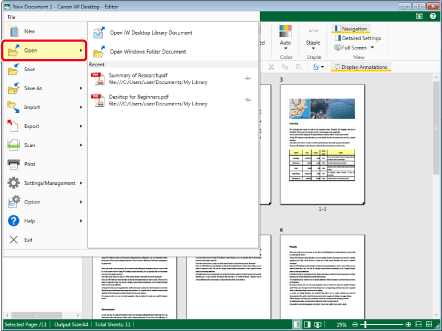
3.
Select the document to open with Desktop Editor from the list in [Recent].
Or, right-click a document in the list and select [Open].
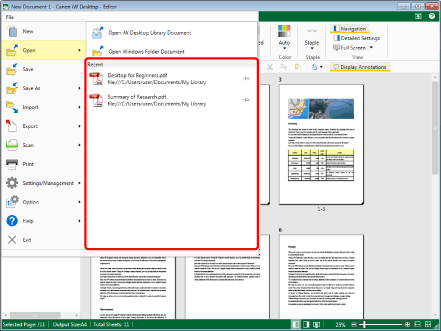
Desktop Editor is started in another screen, and the selected document is displayed.
|
NOTE
|
|
When you select a PDF document with a password set, [Enter Password] is displayed.
When you select a PDF document that has both a password to open the document and a permissions password set, or a PDF document with only a password to open the document set, enter the password and click [OK].
When you select a PDF document that has only a permissions password set, select [Enter password and open], enter the password, and click [OK]. If you select [Display only], you cannot edit, copy, save, or print the document in Desktop Editor.
When you select a PDF document with the Reader Extensions function, a confirmation message is displayed.
Click [Open] if it is OK to delete the Reader Extensions function.
To retain the Reader Extensions function, click [Open Read Mode]. In this case, you cannot edit or save the document in Desktop Editor.
When you select a PDF document in the PDF/A format, a confirmation message is displayed.
To edit a document, click [Open]. If you edit or save a document with Desktop Editor, the document will no longer conform to the PDF/A format.
To keep the document in the PDF/A format, click [Open Read Mode]. In this case, you cannot edit or save the document in Desktop Editor.
If a message is displayed to confirm whether or not to check it out, click [Yes]. The message displayed when checking out can also be hidden. For more information, see the following.
To always display a document in the list in [Recent], click
To delete a document from the list in [Recent], right-click the document to delete in the list and select [Delete from List].
PDF documents and IWB documents opened with Desktop Editor from My Tray are not added to the list in [Recent].
|
Exiting Desktop Editor
This section describes how to exit Desktop Editor.
1.
Click  (Close) on the Desktop Editor screen.
(Close) on the Desktop Editor screen.
Or, select the [File] menu > [Exit].
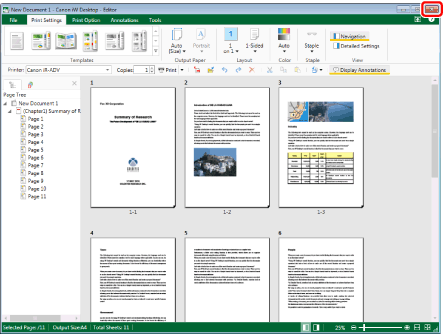
|
NOTE
|
|
If the following dialog box is displayed after saving, select the appropriate update process and then click [OK].
[Checked Out Document Confirmation]
[Modify Shared Document]
|